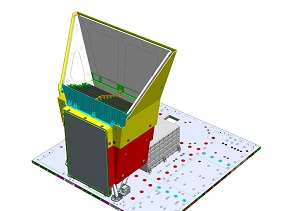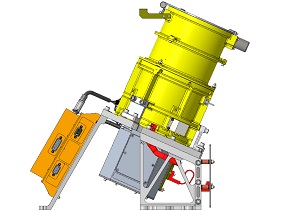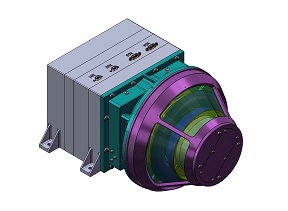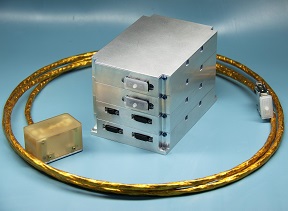Instruments
SMILE's payload consists of two imaging instruments – the wide field of view soft X-ray imager (SXI) and an auroral ultraviolet imager (UVI) – and an in situ measurement package that will work in conjunction with the imagers to explore the properties of the solar wind. This package, built using knowledge and experience gleaned from past missions including ESA's Cluster and ESA-CNSA Double Star fleets, contains a light ion analyser (LIA) and a magnetometer (MAG).
| SXI – Soft X-ray Imager |
| The SXI is a wide-field lobster-eye telescope using micropore optics to spectrally map the location, shape, and motion of Earth's magnetospheric boundaries, including the bow shock, magnetopause, and cusps, by observing emission from the solar wind charge exchange (SWCX) process. The SXI is equipped with two large X-ray-sensitive CCD detectors covering the 0.2 keV to 2.5 keV energy band, and has an optic field of view spanning 15.5° × 26°. |
 |
| Contributions: Developed, built, and calibrated at the University of Leicester, UK, and other institutions throughout Europe. The CCDs are procured from e2v, UK by ESA. |
|
| |
| UVI – UltraViolet Imager |
| The UVI is an ultraviolet camera to image Earth's northern auroral regions. It will study the connection between the processes taking place in the magnetospheric boundaries – as seen by the SXI – and those acting on the charged particles precipitating into our ionosphere. The UVI is a CMOS-based camera centred on the 160-180 nm waveband, with a 10° × 10° field of view. It will have a spatial image resolution at apogee of 150 km, and will use four thin film-coated mirrors to guide light into its detector. The temporal resolution will be up to 60s. |
 |
| Contributions: A joint venture between the University of Calgary (Canada), the Chinese National Space Science Centre, CAS, the Polar Research Institute of China (PRIC), and Centre Spatial de Liège (CSL), Belgium. |
|
| |
| LIA – Light Ion Analyser |
| The LIA will determine the properties and behaviour of the solar wind and magnetosheath under various conditions by measuring the three-dimensional velocity distribution of solar wind ions. It is made of two top-hat-type electrostatic analysers, mounted on opposite sides of the platform. It is capable of sampling the full 4π three-dimensional distribution of the solar wind and magnetosheath, and can measure ions in the energy range 0.2 to 20 keV with a time resolution of up to 0.5s. |
 |
| Contributions: A joint venture between the Chinese National Space Science Centre, CAS, University College London's Mullard Space Science Laboratory (UCL-MSSL), UK, and the Laboratoire de Physique des Plasmas (LPP), France. |
|
| |
| MAG – Magnetometer |
| The MAG will be used to determine the orientation and magnitude of the solar wind's magnetic field, and to detect any solar wind shocks or discontinuities passing over the spacecraft. Two tri-axial sensors will be mounted away from the spacecraft on a 3-m-long boom some 80 cm apart, with a corresponding electronics unit mounted on SMILE's main body. This configuration will let the MAG act as a gradiometer, and allow SMILE's background magnetic field to be accurately determined and subtracted from any measurements. MAG will measure the three components of the magnetic field in the range +/- 12 800 nT. |
 |
| Contributions: A joint venture between the Chinese National Space Science Centre, CAS, and the Space Research Institute, Austrian Academy of Sciences. |
|
Last Update: 1 June 2023




